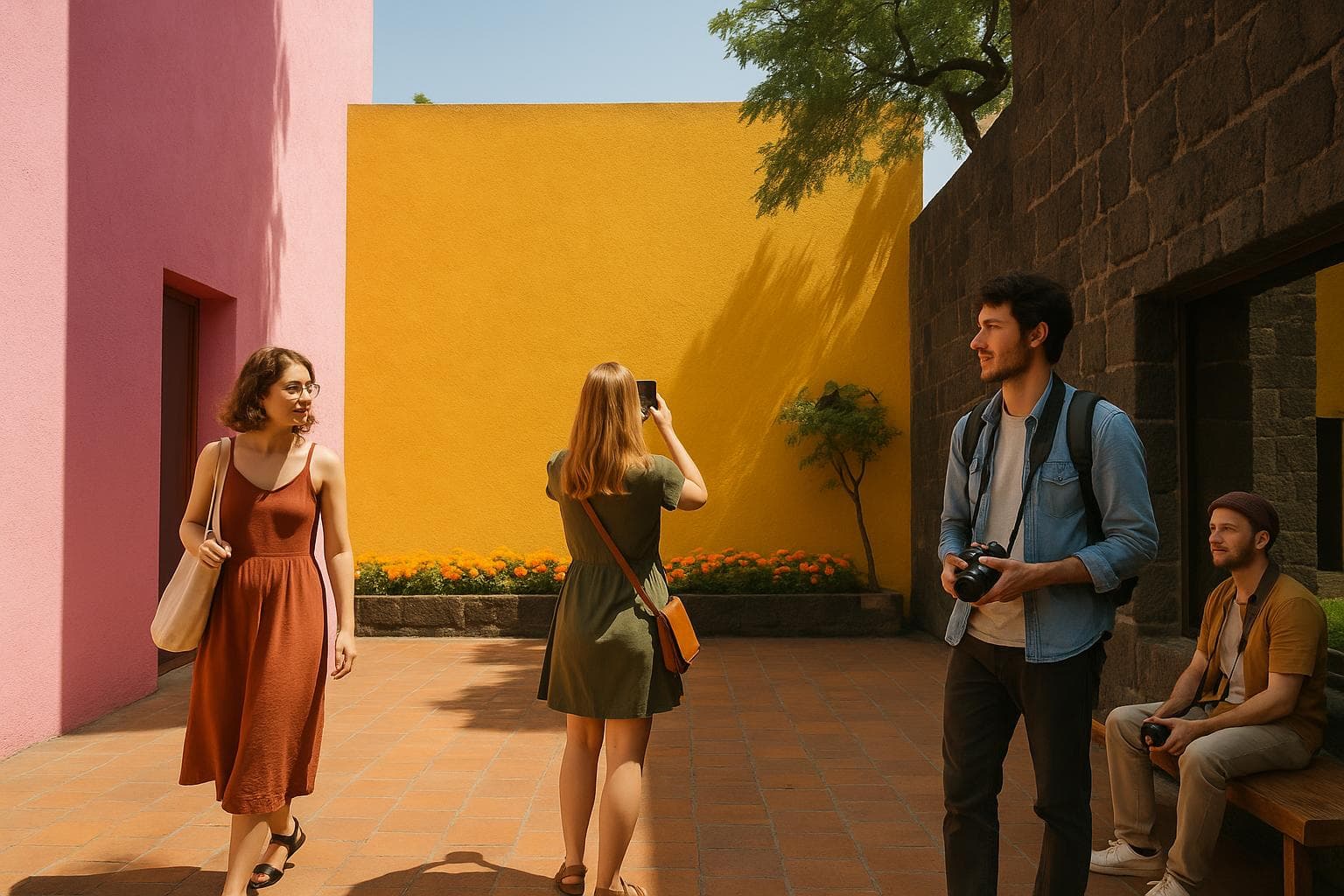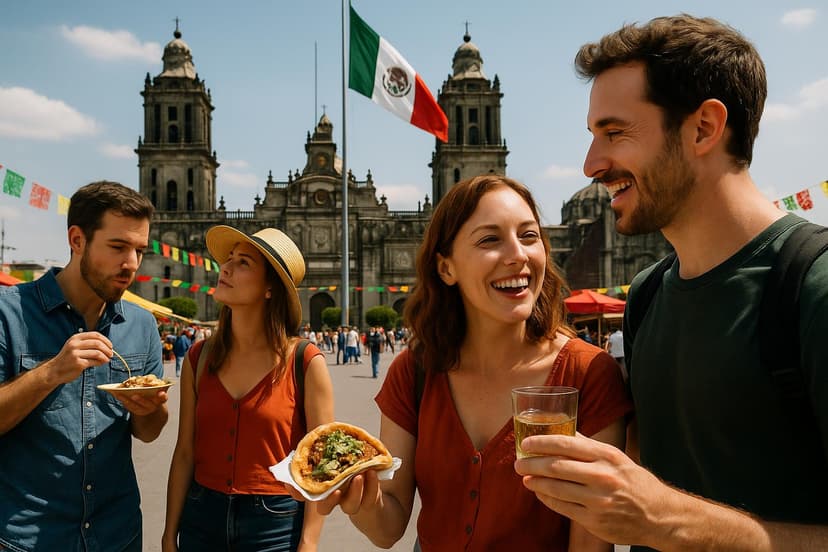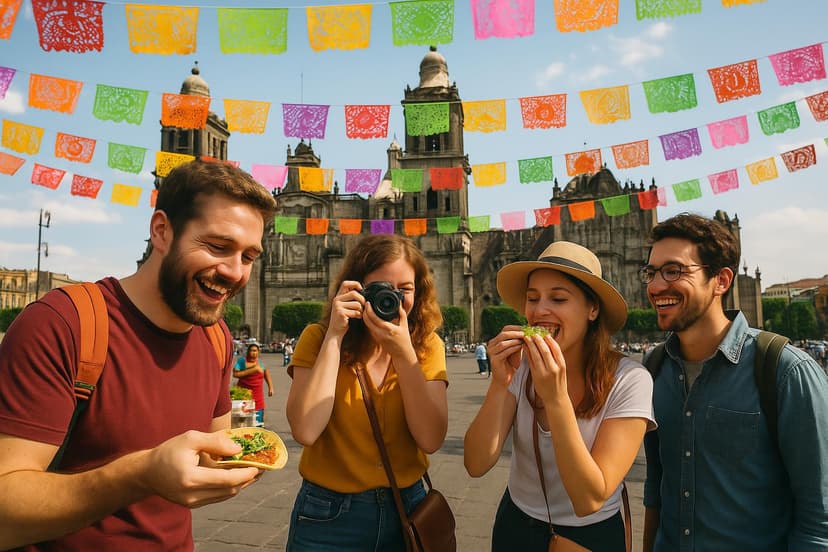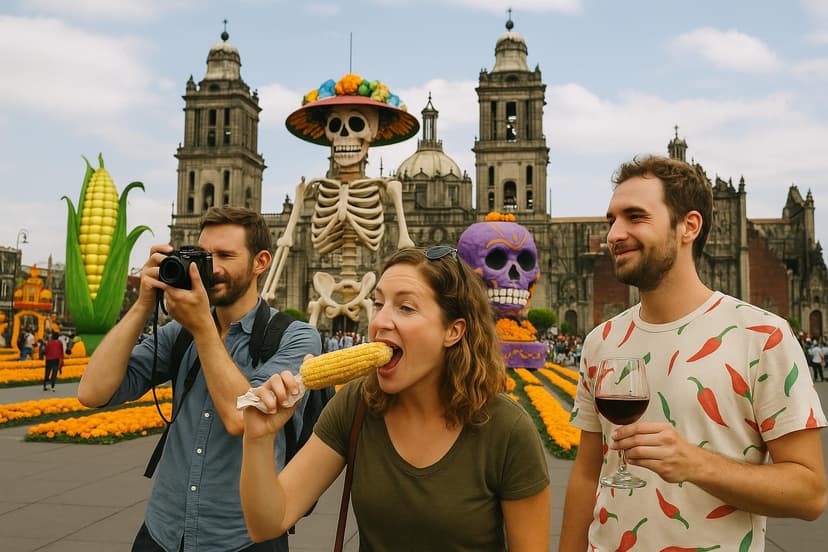Mexico City — Modernist thread: Barragán color, Anahuacalli stone, and Roma studios

A tactile, inquisitive 3-day route for design enthusiasts that traces Luis Barragán’s color, Diego Rivera’s volcanic-stone Anahuacalli, and the lived-in studios and galleries of Roma. Prioritize material details, studio visits, and hands-on encounters with local makers. November in Mexico City is mild and dry — ideal for mixing indoor studio time with late-afternoon light studies.
Highlights
- Guided visit to Casa Luis Barragán — study of color, shadow and memory
- Museo Diego Rivera Anahuacalli — bold volcanic stone and museum-as-collection
- Studio and gallery circuit in Colonia Roma — MODO, Galería OMR, Proyectos Monclova
- Hands-on printmaking at Taller de Gráfica Popular and artisan exploration at La Ciudadela
- Design-minded meals at Mercado Roma and pastry breaks at Panadería Rosetta
Itinerary
Day 1
Barragán morning and Centro design afternoon — concentrates on built color and intimate modernist houses, then decorative-arts context in the historic center.
Guided visit — Casa Luis Barragán
Start with a small-group, timed guided tour of Luis Barragán’s house and studio to investigate his careful use of color, planes of light and built furniture.
Tips from local experts:
- Book the timed guided tour weeks ahead (Casa Luis Barragán limits visitors); request permission to focus on garden light in November afternoons if available.
- Tactile note for designers: bring a small notebook and a textile sample to compare how Barragán frames color (touch is not allowed inside; use samples outside in the courtyard)
- Accessibility: there are steps and narrow doors — contact the site in advance if mobility assistance is required.
Transfer — Drive to Casa Gilardi
Short transfer traveling toward Casa Gilardi; use this time to skim Barragán sketches and photos or talk with your guide about spatial sequencing.
Tips from local experts:
- Ask the driver to pause at a good viewpoint for quick photos of neighborhood mid-century facades.
- Use this pause to compare how scale changes between Barragán's house and Gilardi's intimate rooms.
- If using rideshare, choose a vehicle that can hold any portfolio folders safely flat to avoid creasing.
Visit — Casa Gilardi
A focused visit to Casa Gilardi to observe Barragán’s later spatial gestures — note the famous jacaranda-framed light well and the use of single-color fields.
Tips from local experts:
- Casa Gilardi often requires appointment — confirm visiting hours and ask to see the courtyard light at midday where possible.
- Bring a color swatch book or phone photo palette app to sample the house’s saturated hues for later reference.
- Respect the quiet: this is a lived-in architecture icon. Use a whisper tone and avoid flash photography.
Transfer — Travel to Centro Histórico
Short transfer toward the historic center where Franz Mayer sits — a good moment to review local modernist contexts and decorative arts collections.
Tips from local experts:
- Traffic can vary; plan buffer time for Planetario or Chapultepec cross-traffic in November events.
- Use the time to mark items to look for at Franz Mayer: ironwork, tile patterns and tiled furniture.
- If you prefer, ask to be dropped near a quiet café for a restroom break before the museum visit.
Lunch — Restaurante Limosneros (design-friendly Centro tableware and atmosphere)
A central lunch in the historic core with thoughtful plating and local ingredients — useful pause to discuss materials and museum hypotheses.
Tips from local experts:
- Request a table by the window to observe the historic stone facades — tactile contrasts between stone and glazed pottery on the table are instructive.
- Ask staff about local ceramicists who supply their plates — many CDMX restaurants use small-batch pottery.
- Vegetarian options are strong; food is a quiet, design-conscious experience rather than tourist spectacle.
Transfer — Short transfer to Museo Franz Mayer
A brief transfer/walk to Museo Franz Mayer to continue the day with decorative arts and historic design objects.
Tips from local experts:
- Walk if weather is clear: November mornings/early afternoons are usually dry and pleasant for a short route.
- Use this stretch to compare urban stonework near the cathedral with the museum’s collection of tiles and metalwork.
- Pick up a map of the museum before entering to prioritize sections with textiles and furniture.
Museum visit — Museo Franz Mayer
Explore decorative arts, historic furniture, and design objects to contextualize modernist color and craft in Mexican domestic interiors.
Tips from local experts:
- Head first to the European and Mexican silver and furniture rooms to study scale and joinery details up close.
- Look for explanatory labels that note maker names — many decorative pieces are by workshops still operating in Mexico City.
- If you're photographing textures, use available natural light in galleries and avoid flash that can damage surfaces.
Evening — Tactile stroll: Centro Histórico materials walk
An easy, curated stroll to feel and compare urban materials: cantera, tezontle, glazed tile, and painted facades as dusk sets in.
Tips from local experts:
- Aim for the golden hour: November sunsets in CDMX are early and light quality over stonework is excellent for studying hue shifts.
- Touch (where allowed) stone plinths and tile edges to note different finishes — avoid delicate carvings and always ask permission if unsure.
- If you need quieter perspectives, detour down minor side streets off the main plaza to see residential architectural details.
Day 2
Anahuacalli’s volcanic stone and artisan encounters — morning at Rivera’s stone museum, mid-day artisan market, and an afternoon hands-on printmaking workshop.
Morning visit — Museo Diego Rivera Anahuacalli
Explore Diego Rivera’s rock-built museum: a study in heavy volcanic-material massing, hand-crafted masonry and the idea of a personal collection made architectural.
Tips from local experts:
- Observe mortar joints and the volcanic stone textures up close — bring a macro-capable camera or loupe if you want to document surface finish.
- The museum sits on a small hill and is breezy in November — bring a light jacket for courtyard time.
- Ask the attendant about Rivera’s display strategy: how objects are grouped by texture and material rather than chronology.
Transfer — Drive to Mercado de Artesanías La Ciudadela
Short transfer toward La Ciudadela artisan market — a concentrated place to meet makers of textiles, ceramics and metalwork.
Tips from local experts:
- Use the short drive to list specific crafts you want to see: textiles, tinwork, majolica tiles, or leather goods.
- Ask your driver to drop you at the market’s quiet entrance to avoid the busiest rows first.
- Carry smaller bills for direct purchases with artisans; bargaining is cultural but keep it respectful.
Midday — Mercado de Artesanías La Ciudadela (artisan exploration and light shopping)
Browse stalls of contemporary and traditional makers; look for small-scale furniture makers, textile weavers and tile vendors.
Tips from local experts:
- Seek out vendors who will demonstrate their craft — ask to see a short demo of weaving or tile finishing.
- November is dry and the market is less humid — textures are crisp and ideal for tactile comparison.
- If planning to ship purchases, ask vendors if they do small export-packaging or recommend local shippers.
Transfer — To Taller de Gráfica Popular (prepare for printmaking)
Short transfer toward the workshop neighborhood. Use this time to set goals for your print — edition size, paper and inks.
Tips from local experts:
- Ask the workshop to prepare a small plate size in advance if you want to work on a specific motif.
- Bring reference sketches from the morning’s visits — stone textures and color notes translate well to relief or monotype.
- Double-check what protective clothing the workshop recommends; many inks are water-soluble but staining.
Hands-on workshop — Taller de Gráfica Popular (printmaking session)
Participate in a hands-on relief or linocut session with local printmakers: learn registration, inking and editioning techniques.
Tips from local experts:
- Tell the workshop leader you’re a designer and want to focus on texture translation (stone to paper) — they can adapt the exercise.
- Wear clothes you don't mind getting ink on; many studios provide aprons but stains happen.
- Request a short demo of hand-inking techniques used historically by Mexican graphic print studios for a tactile study.
Transfer — Move to Coyoacán Centro for an evening stroll
Transfer into the heart of Coyoacán to relax, review the day’s sketches and enjoy a slower evening neighborhood atmosphere.
Tips from local experts:
- Coyoacán is pleasant in November evenings — the light softens building colors and is ideal for comparing tone notes from the day.
- If you're tired, stop at a cafe with local ceramics to compare dishware textures and finishes.
- Ask for a short detour to visit a known artisan storefront if time allows (many small makers stay open into early evening).
Neighborhood — Coyoacán Centro tactile stroll and café
Walk Coyoacán’s plazas and side streets to observe vernacular materials — colonial stone, colonial tiles and painted facades — while debriefing the day.
Tips from local experts:
- Stop in a small café to compare their ceramic cups and saucers — ask where they source tableware from local ceramists.
- Look for door knockers, iron grilles and carved woodwork: these small details often reveal maker signatures.
- If cold, choose a café with outdoor heaters — November nights cool down after sunset; layering is advisable.
Day 3
Roma and Condesa — studio and gallery day with object-focused museums, independent galleries, and a closing drinks session to discuss networks and local makers.
Breakfast — Panadería Rosetta (design-minded pastry and light study)
Begin with pastries at Panadería Rosetta — the bakery’s interior design and plated breads are a nice early sensory comparison for materials and craft.
Tips from local experts:
- Try to sit by the window to watch pedestrian life and note how storefronts in Roma use tile and signage.
- Inspect the bakery’s ceramics and plating — many bakeries collaborate with small-scale potters.
- Beat the lines by arriving early (Panadería Rosetta fills quickly on weekend mornings).
Transfer — Short walk to Casa Lamm
Walk into Casa Lamm’s cultural center in Roma for exhibitions and design-focused programs.
Tips from local experts:
- Take the quieter side streets of Roma to study residential facade repair and painted plaster textures.
- There are many small design shops en route — note shopfront typography for later gallery comparison.
- Carry a small umbrella if forecasts predict a November shower (rare but possible).
Visit — Casa Lamm Centro de Cultura
Explore Casa Lamm’s rotating exhibitions, design talks, and small-library resources — a good place to meet local curators or designers.
Tips from local experts:
- Check the daily program on arrival for short talks or artist visits that can deepen studio contacts.
- The building itself is a well-preserved mansion — examine interior moldings, floor finishes and original fixtures.
- If interested in local design publications, visit their small bookshop for intimate prints and zines.
Transfer — Walk to MODO (Museo del Objeto del Objeto)
A 15-minute stroll to MODO, whose collection of designed objects provides context for material culture and everyday design.
Tips from local experts:
- Use the walk to map out gallery visits for the afternoon; Roma is dense with creative spaces.
- Observe shopfront signage and poster design in the neighborhood as informal object studies.
- Look for small makers’ shops en route for quick inspiration or sourcing notes.
Museum visit — MODO Museo del Objeto del Objeto
Study curated displays of packaging, furniture and everyday objects — great for designers interested in production, branding and material narratives.
Tips from local experts:
- Ask staff about recent acquisitions or local designers featured in temporary shows — MODO often spotlights Mexican object designers.
- Pay attention to labels for maker credits and production techniques; catalog notes can point to local workshops.
- Bring gloves if the museum offers tactile sessions; MODO occasionally runs object-handling events.
Lunch — Mercado Roma (design-forward food hall and interiors)
A modern food market with varied vendors and a thoughtfully designed interior — a useful case study in adaptive reuse and hospitality set design.
Tips from local experts:
- Walk the mezzanine and note how vendor stalls use materials: metal, wood and painted signage speak to independent branding choices.
- Sit near communal tables to observe plateware choices across vendors — great for material comparisons.
- If buying small design objects from vendors, ask about maker provenance — many vendors work directly with artisans.
Transfer — Short walk to Galería OMR
Walk into the gallery circuit: Roma’s galleries are often a five- to ten-minute stroll apart — observe signage and window displays.
Tips from local experts:
- Take the street route that passes small studios — many artists pin flyers announcing open studio days.
- Check gallery hours in advance (some are by appointment) and call if necessary to ensure curator availability.
- Bring business cards and a polite portfolio sheet if you would like to request studio contacts.
Gallery visit — Galería OMR
Tour OMR’s program focusing on contemporary Mexican and international artists — observe material choices, installations and gallery display strategies.
Tips from local experts:
- Ask the gallery attendant about the gallery’s recent projects and any recommended artist studios to visit.
- Take time to note mounting techniques and lighting rigs — galleries reveal practical solutions for showing objects.
- If possible, request a quick chat with a curator about local talent networks and studio recommendations.
Transfer — Walk to Proyectos Monclova
A short walk through Roma’s side streets toward a smaller, often experimental gallery space.
Tips from local experts:
- Enjoy window-shopping on the route — many small print and poster studios display outdoor samples.
- If weather turns chilly, duck into a small shop for a quick material study of textiles or pigments.
- Take notes on storefront lighting solutions many small galleries use to economize without losing display quality.
Gallery visit — Proyectos Monclova
Visit this smaller independent gallery to absorb emerging practices and potential studio-network contacts.
Tips from local experts:
- Smaller galleries often have direct lines to artists — ask for studio visit contacts or upcoming open-studio dates.
- Observe how small spaces manage visitor flow and lighting: great ideas for tight studio exhibitions.
- Buy a catalog or small edition if available — independent galleries frequently sell limited prints.
Transfer — Time to the evening bar in Roma/Condesa
Move to a nearby cocktail bar for a late evening debrief and networking over drinks.
Tips from local experts:
- Evenings in November are comfortably cool — consider a table on a covered patio if available.
- Use this transit to swap contact details with local curators or fellow designers met during the day.
- If you want a quieter end to the day, request a corner table to review photos and notes.
Evening — Drinks and debrief at Licorería Limantour (Roma)
A design-minded cocktail bar to close the trip: talk materials, collate contacts, and plan follow-ups with local makers.
Tips from local experts:
- Ask the bartender about drinkware origins; many bars in CDMX use locally made glassware or ceramics.
- Limit heavy spirits if you’re flying the next day — November evenings can be long for wrap-up conversations.
- Use this final stop to confirm any studio appointments you want to transform into ongoing collaborations.
More options in Mexico City
Explore more travel plans and guides for Mexico City.







